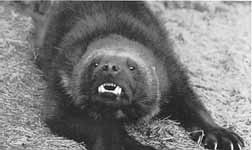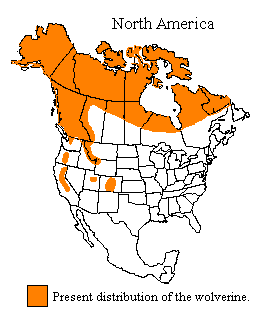WOLVERINES?
Seems like wolverines are everywhere! Or not?
There are currently no wolverines in the Wolverine State (other than a
few in Ann Arbor). The last known specimen is in the stuffed animal collection of
Gary Kaberle of Traverse City; it was killed in the 1860's. As far as is known, there
is no evidence that wolverines were ever commercially trapped in Michigan.

Source: Unknown
Fielding Yost, famous football coach of the University of Michigan Wolverines, recounts his futile efforts to find any solid evidence of wolverines in Michigan in an article entitled, "The Wolverine", Michigan History 27: 581- 89. More recently Michigan State University zoologist Rollin Baker argued that a few wolverines were found in northern Michigan as late as the 19th century, but he admitted that much of his evidence for this conclusion was hearsay. Why the name of this beast, sometimes called the "glutton", was applied to residents of Michigan and to the state is not certain. The wolverine was an animal the Indians had traditionally disliked intensely. Some believe that when the Americans moved into Michigan in the 1830s and gobbled up the Indians’ land, the Indians began calling these settlers "wolverines" because it was the worst thing they could call them.
-

Source: Unknown
Some people believe that Ohioans gave Michigan the nickname around 1835 during a
dispute over the Toledo strip, a piece of land along the border between Ohio and Michigan.
Rumors in Ohio at the time described Michiganians as being as vicious and bloodthirsty as
wolverines. This dispute became known as the Toledo War.
Still others insist that the nickname "Wolverine State" comes
form early trappers. Wolverine pelts, trapped in northern Canada and relayed through
Michigan to eastern cities, often bore the name "Sault Ste. Marie, Michigan" on
their shipping labels.
Here's a bit of truth about wolverines. They are very rare,
yet not endangered. A few survivors have retreated to make a last stand in remote
mountains in far-northern Canada. A few are killed each year in traps in Montana.
Wolverines --also called Indian devils, skunk bear, carcajou, the evil
one, quiquehatch-- are the larger cousins of otters, weasels, and skunks. Their
scientific name is Gulo gulo ("glutton glutton"). They are not
little wolves. At 25-55 pounds, they seem like a cross between a racoon and a
grizzly--and yet they are utterly unlike anything else.
With their long fur, muscular physique, nasty claws, and peculiar
loping gait, they seem most at home in snowy, hostile places-deep conifer forests, tundra,
above-treeline mountaintops, Arctic ice floes. Thinly spread and probably slow to
reproduce, they are circumpolar, living in Alaska, western Canada, Scandinavia, and
northern Russia. They once ranged through the northern United States and down the Sierra
Nevada and Rocky Mountains to New Mexico.
They are slow but tireless travelers; bush pilots have seen them run 40
miles without rest and trundle steadily up lifeless mountain walls or across glaciers.
Their weirdly oversize feet take them on snow where others flounder and die; they are
expert swimmers, diggers and tree climbers. When other animals flee south, go into
hibernation, or drop into death, wolverines roam.
They are the ultimate scavengers: Indains refused to eat them, because
wolverines dine mainly on the dead-often big game but, if given the chance, humans. Too
slow and small to prey efficiently on deer and other large animals, yet so big they
probably require the meat a large kill provides, they depend on wolves, bears, starvation,
cold, and the rare human hunter to do their killing for them. Then they sneak in for
leftovers.
Their powerful jaws can crush frozen bones-perhaps the only leavings in
barren winter-and scientists think that if necessary they can subsist on those pitiful
scraps alone. Nearly impossible to track without snow, they may be more omnivorous than we
think. Researchers have glimpsed them eating mushrooms, berries, bird eggs, and wasp
larvae. Snow tracks and scats have revealed that they kill porcupines and hares; observers
have seen them stalk baby seals on the Arctic ice pack. Other rare eyewitnesses have
watched them outmaneuver an occasional caribou, vaulting high onto its neck or
hindquarters and riding the victim bareback while tearing in. And of course, in fall in
various football stadiums, they try in vain to prey on MSU Spartans.
As for the fierceness this implies, there are plenty of tales. Entire
wolf packs are said to slink away from kills at a wolverine’s approach. In the 1960s
an Alaskan Inuit told anthropologist Nicholas Gubser that he’d seen a 1,000-pound
polar bear crush a wolverine to it chest; the bear dropped dead when the wolverine
excavated its heart. However, biologists and trappers say these stories are at best
exceptions at worst whoppers: 30-pound wolverines smartly avoid carcasses guarded by 300-
to 1000-pound bears. On the other hand, a wolverine can present a whirling mass of teeth
and claws to beat off a lone, much larger wolf. And anyone who’s heard its
grizzlylike rumble at close range-as I have-knows he has encountered a force that cannot
be measured by mere size.
Luckily, wolverines don’t often attack people; unlike their
cousins that haunt suburban garbage cans, they flee settlement fast and far in advance.
Perhaps because of this, the wolverine has long been revered and feared as the archetype
of supernatural cleverness and even malice. Its Latin name, Gulo gulo, means
glutton, in reference to the now-disproven idea that it devours unlimited quantities of
meat. The Cree called it Ommeethatsees: One Who Like to Rob; the Alaskan Inuit, Kee-wa-har-kess:
the Evil One. According to the Dene elders of Canada’s Northwest Territories, where
wolverines still dwell, Wolverines once snatched human children and raised them for food.
Settlers noted the animal’s uncanny ability to chew through
foot-thick cabin walls and remove everything edible and to raid traplines set for small
furbearers, stealing bait, animals, and traps entire. So the settlers laid a big
trap-steel jaws this time. They also chopped up the deep wilderness the animals require.
The wolverine disappeared from the eastern United States and the Great Lakes region by the
mid-1800s. By the early 1900s it was gone from most of the West. There have been no
confirmed sightings in Canada east of Hudson Bay since the 1950s, following massive
predator-poisoning programs. Many states passed protections long after the animals seemed
gone-except for Alaska and Montana, where carcasses from legal trapping provide proof the
animals are still there.
Where else in the United States they might be (besides Idaho, which has
a small protected population) is anyone’s guess. In April 1995 the US Fish and
Wildlife Service used the animal’s rarity and mysterious nature to deny it threatened
status, claiming, Catch-22-like, that there wasn’t enough information to warrant
listing it. Despite recent sightings in western states, including Oregon and Washington,
little definitive evidence has surfaced for years or even decades. The last specimen of a
California wolverine was taken in 1925, near Yosemite National Park--yet hikers keep
reporting wolverine-like creatures and tracks in the high Sierra Nevada.
Some sightings seem credible, and since 1991 California scientists and
volunteers have operated some 200 bait stations rigged with motion-sensitive cameras to
come up with proof of the animals’ presence. They have photographed other obscure
carnivores, such as fishers and a Sierra red fox, but not a single wolverine. Since 1979
Colorado wildlife officers have investigated more than 100 sightings and snow tracks, but
by the time they return with a camera, the tracks have invariably drifted over. The
closest they’ve come to a real wolverine was in 1982, when they nabbed an escapee
from a Colorado Springs zoo who had gotten himself hopelessly tangled in a Denver window
well.
This material has been compiled for educational use only, and may not be reproduced without permission. One copy may be printed for personal use. Please contact Randall Schaetzl (soils@msu.edu) for more information or permissions.